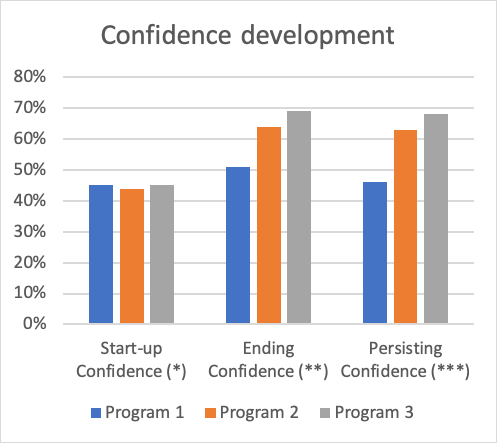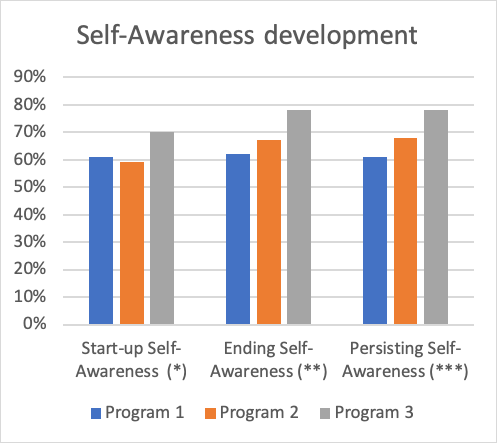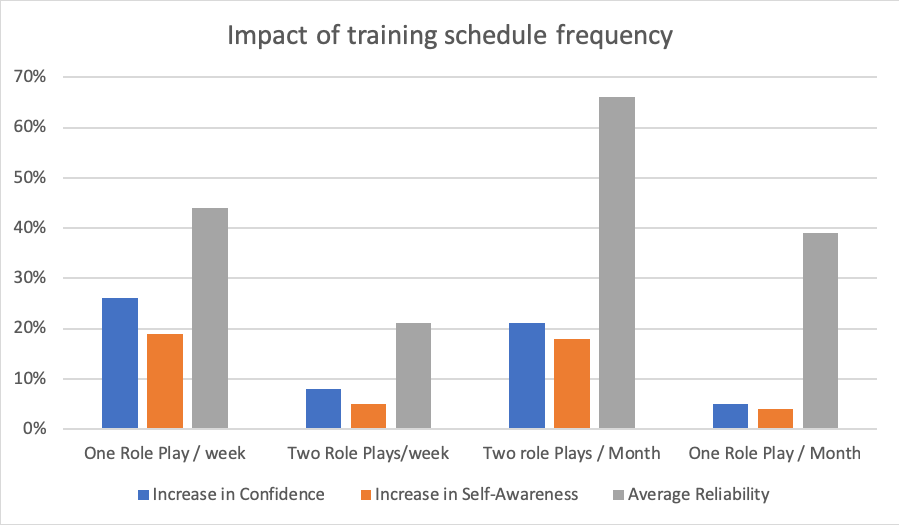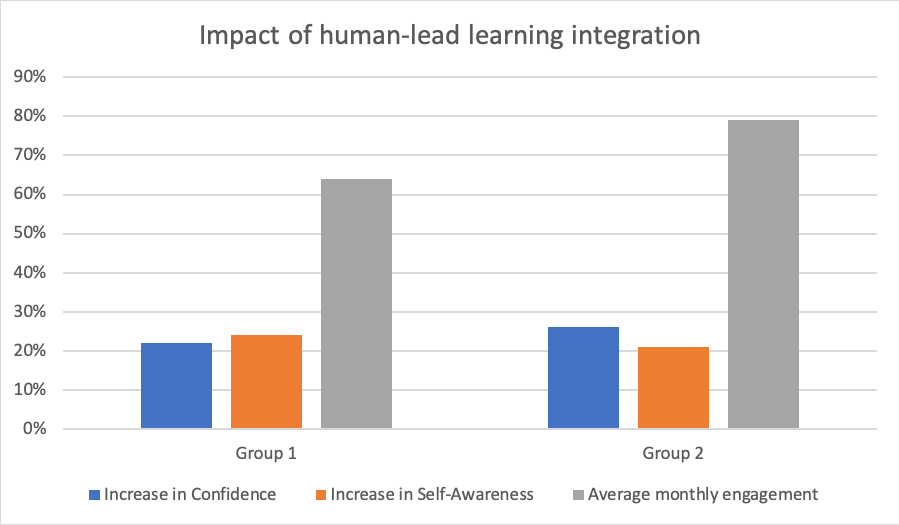
I recently wrote (“Building a Community of Leadership Abundance”) about the importance of reaching and maintaining mastery in leadership conversations as a way to convey energy, meaning and purpose throughout any team.
In fact, to achieve the highest performance in conversational skills, it requires a high degree of personal confidence in the task and of self-awareness on our own performance.
Both can be developed through practical training in a much more efficient way (“From Critical to Empowering Conversations: Let’s Change the World Using the C-FACTOR”) than simply by only taking dedicated traditional courses, whatever their format being knowledge-based or inspirational.
Digital Role Play is a great way to practice critical conversations. We have seen in this article (“Digital Role Plays, the Best Way to Develop Conversational Leadership”) how it can shape a better approach to conversational leadership and we have extensive evidence about the fact that consistent practice (“How Practicing on Digital Role Play Improves Performance: a Case Study”) leads to a more stable acquisition of the fundamental skills we need.
To achieve the highest performance in conversational skills, it requires a high degree of personal confidence in the task and of self-awareness on our own performance.
The key question, however, when it comes to organizing a practice schedule is about how to balance the effort, the frequency and the type of exercise to meet the needs and the availability of every single Leader who will be enrolled in the program.
Much too often, the training program takes a short-term scheduling approach into account as defined by the Line and/or by the L&D priorities with the risk of underestimating how it actually fits with the trainees’ needs and availability.
Today, with the help of in-field case studies, I will focus on how a leadership training program, based on Digital Role Play, should be designed to optimize the results of conversational leadership skills development.
Much too often, the training program takes a short-term scheduling approach into account as defined by the Line and/or by the L&D priorities with the risk of underestimating how it actually fits with the trainees’ needs and availability.
The following best practices are taken from the analysis of over 15k Leaders, belonging to 20+ different companies. We conducted this extensive study for over 18 months, which then led to the development of an Adaptive Learning Program (described in this article “SkillGym Digital Fitness: Pure, Adaptive Leadership Training”).
It was also very useful in forming the reasoning around the following six characteristics of any well-designed training program:
- Program length
- Training frequency
- Repetitions
- Choice of subjects
- Adaptive schedule
- Learning integrations
1. Program length
The first key question is, of course, whether the practical training should be limited to a relatively short and well-defined period of time or if trainees should be left free to develop their skills across a much longer horizon.
What we normally see before introducing Digital Role Plays is that the typical L&D strategy is about adding a long-tail of practical exercises at the end of a 2-day leadership course (whatever the format). On average, this extension can last between 3 to 8 weeks and trainees are assigned with a number of exercises, often including some form of practical training on critical conversations.
We have monitored three different approaches:
- Program 1: an eight-week practical training including role play activity (150 Leaders involved, 1 role play/week) – we have also assessed this group with Digital Role Play to have a common measurement ground
- Program 2: a six-month dedicated Bootcamp on critical conversations with Digital Role Play (240 Leaders involved, 1 role play/week)
- Program 3: a nine-month dedicated Bootcamp on critical conversations with Digital Role Play (207 Leaders involved, 1 role play/week)


Notes:
(*) the two factors were assessed using the same Digital Role Play at the beginning of each program
(**) the same assessment was done at the end of each program
(***) trainees were further assessed after six months from the conclusion of their program
As you can see in the above charts, those with the longer tail of training outperformed the other ones in terms of quality in Confidence and Self-Awareness after six months from their last exercise.
Clearly the duration of the training program has a correlation here with the enduring impactover time of the two leadership factors.
In fact, we noticed this evidence popping up all the time and we are more and more inclined to consider practicing on critical conversation as a strategy that should be implemented on an on-going basis rather than a one-shot activity following a formal course.
Ideally, we can expect the best results when formal courses are planned along with the ongoing practical training happening in the background rather than the other way around.
2. Training frequency
Another very important ingredient of a well-balanced training program is the frequency with which the trainees participate in exercises.
To find a suitable balance, keeping into account both the effort and the results, we would consider the following two KPIs: Confidence Improvement over Reliability (measuring the actual participation of the trainee to the scheduled appointment).
We noticed that although an increase in training frequency may lead to a theoretical increase in performance, it is not always the case since practice that requires too much frequency often leads to disengagement.
The following shows the results, comparing the training program of the four groups of trainees (each group with an average of 200+ Leaders) measured over a nine-months timeline.
Each group was assigned to a different program with different frequency schedule of training:
- Group 1: One Role Play / Week
- Group 2: Two Role Plays / Week
- Group 3: Two Role Plays / Month
- Group 4: One Role Play / Month

Clearly the best results in Confidence and Self-Awareness increase are tracked with the:
- One Role Play / Week
- Two Role Plays / Month
In fact, that’s where the scheduled program meets the peak of trainees’ actual commitment (reliability of the user to respect the scheduled training appointments), returning a better result in terms of confidence development as well.
When the schedule is too loose or too tight, two things happen:
- On one side, trainees get saturated with the practice (no added effect) or too diluted (the experience is not frequent enough to develop the so-called Deja-vu effect)
- On the other side, the actual practicing (over the expected scheduled practices) tend to slow down, thus affecting the result
3. Repetitions
Practicing is repetition, it’s an old, but very true statement. So, the next question is: how many times the same situation should be repeated and under which pedagogical conditions, in order to fix the experience deep into one’s behaviors?
It’s a key point: no one likes to repeat the same exercise too many times (i.e.: replaying the same role play to fine-tune behaviors and achieve better performance), however repeating the exercise allows for greater development in self-awareness. It’s a not easy to manage the trade-off.
There is no unique answer here. Much depends on the type of experience, the conditions of execution, the focus of the trainee and more, such as:
- The complexity of the role play (for example, introducing AI algorithms helps deliver a similar, but still slightly different experience, what we call “authentic” experience)
- The time distance between repetition. The larger, the better. Both in terms of user experience and in terms of pedagogical efficiency
My recommendation would be:
- Rely on AI-based Digital Role Play to ensure a much more realistic user experience (vs a branched and very predictable solution)
- Make sure that the training schedule is organized in a way that the repetition happens either immediately after the previous interview (only once in this case; pedagogical approach: experience intensity) or, on the contrary and preferred, after at least 4-6 weeks (pedagogical approach: experience dilution)
- Allow a maximum of 3-4 repetitions of the same scenario along a 1-year program, making sure to contextualize (i.e.: explain very well): why the trainee should repeat the same exercise and where to look at for improvements
- Adding more and more repetitions of the same scenario won’t add any value to fixing the behavior, especially if it is done with intensity in a short period of time
Bringing the three above variables together (duration, frequency, repetition), my experience is that a good balance would be:
- A year-long schedule upon which all the leadership traditional training can reconnect
- A smooth and consistent frequency of around two interviews / month
- A slight repetition of key interviews (those where it makes sense to reflect on), say two to three times / year
Of course, it’s not just about quantity. So, keep reading below.
4. Choice of subjects
Correctly choosing the exercise is just as important as the pace of training. There is no point in practicing something that does not matter.
Conversations are not all the same. On one side, of course, the development of factors such as self-confidence can happen with any conversation if supported with a good pedagogical approach.
On the other side, however, other factors such as conversational confidence and even certain behavior-related skills are very situation sensitive. So, it is important to balance wisely from the point of view of which scenario to assign.
Again, quite often we see certain L&D strategies focusing on one or two specific competencies: best-selling are things like “giving feedback”, “negotiate”, “solving conflicts” and so on.
That’s certainly one way: focusing on specific areas where gaps have been detected.
It makes a lot of sense, of course.
However, we noticed that the entire set of skills behind conversational leadership improve faster and in a more balanced way when the program focuses on a broader set of types of conversations and situations. The best practice here would be to fly higher over the single circumstance or need and try to extend the training program to a much more comprehensive set of skills.
One good way would be to consider the 80/20 principle, by which 20% of the situations generate 80% of the impact.
Select the 20% of all types of conversation that normally happen at work and create a training program covering all of them over an extended period of practice (according to the above indications with regards duration, frequency and repetition).
5. Adaptive schedule
The best approach for optimizing the pace and the content mix is definitely that of embracing the so-called adaptive learning strategy. It’s becoming a more and more popular topic nowadays and it consists of tweaking the content and the intensity of the learning program according to each trainee’s unique and developing needs.
Often though, it’s easier said than done, especially if you are delivering a very extensive (in time and in number of trainees) training program with multiple variables (quantitative and qualitative) to consider for measuring the impact of your choices and adjusting the formula along the way.
My best advice here is to rely on AI-based frameworks capable of generating and analyzing in real time large quantities of data coming from the usage of the training tool and providing a self-adjusting way to fine-tune both the pace and the content mix of the training.
A good example of an adaptive training program for Digital Role Play is discussed in this article (“SkillGym Digital Fitness: Pure, Adaptive Leadership Training”).
Certainly, the possibility adapting the training contents and pace to the need, availability, focus and reliability of each trainee can result in a much higher long-term engagement and, consequently, better long-term results in skills’ improvement.
6. Learning integrations
We often see this scenario: the leadership course is designed around a 2-3 day inspirational and knowledge-based experience and some follow-up is then prescribed for the following 4-8 weeks.
As discussed above, designing a training based on practice delivers a much higher impact:
- On performance KPIs
- On long-term competency retention
- On overall engagement
However, I am not saying that you don’t need any form of traditional learning formats. Instead, all our evidence clearly shows the importance of defining a well-balanced mix between self-paced practicing on Digital Role Play, face-to-face inspirational training and human-lead (live or remote) support.
Look at this case study: two groups of around 150 Leaders each (comparable in terms of age, seniority and role).
| Training Program Group 1 | Training Program Group 2 |
|---|---|
One initial day of inspirational training (classes of 10-12 people) |
One initial day of inspirational training (classes of 10-12 people) |
Six months of self-paced training on Digital Role Play |
Six months of self-paced training on Digital Role Play |
No other human support or knowledge-based integration along the way |
Monthly individual remote support (20 mins. / trainee) |
Three one-day live sessions spread along the entire program for re-cap and discussion (10 people / group) |

Clearly, introducing face-to-face and remote support in the form of inspirational, knowledge-feeding and discussion-based interaction made a significant difference in the way the two different groups kept their engagement along the way.
It is not easy to evaluate the difference between the two groups in terms of performance goal achievement, mainly because improvements are very much related to practicing.
However, increasing and maintaining the engagement, as well as providing on-time human support is certainly one of the most important elements for the best integration of a well-balanced training program.
Conclusions
We have seen six key elements that you should always consider when planning for an efficient conversational leadership training program.
According to best practices that we continuously collect and from the evidence shown above, I think that the following can be considered a fairly well-balanced formula:
- Plan for the long term. Instead of adding a few weeks of exercises as the long tail of a scheduled leadership class, try to flip it over. Design a long-term practice schedule upon which you will add-on any relevant learning activity to keep the momentum and deliver human-lead inspiration and support.
- Adapt frequency of use and repetition according to the audience, with the scope in mind of maximizing the reliability of trainees.
- If you can rely on a Digital Role Play tool to allow adaptive scheduling, go for it. It probably won’t cost you that much more, but it certainly delivers higher value in terms of consistent engagement of users.
- Make sure that you cover all the areas of leadership conversations, instead of focusing on the problem of the day. But do so wisely. Choose the 20% of conversations that make 80% of the difference in leadership effectiveness.
- Keep the human factor as a part of your formula. Self-paced practicing is powerful, but it becomes even more effective when mixed with real inspirational training delivered at the right time.
Ideally, we can expect the best results when formal courses are planned along with ongoing practical training happening in the background rather than the other way around.
At this point you may want to learn more about:
- Our approach to adaptive learning, with SkillGym Digital Fitness (“SkillGym Digital Fitness: Pure, Adaptive Leadership Training”)
- The way we deliver authentic Digital Role Play, by booking a 1-hour discovery call
Thanks for reading!

